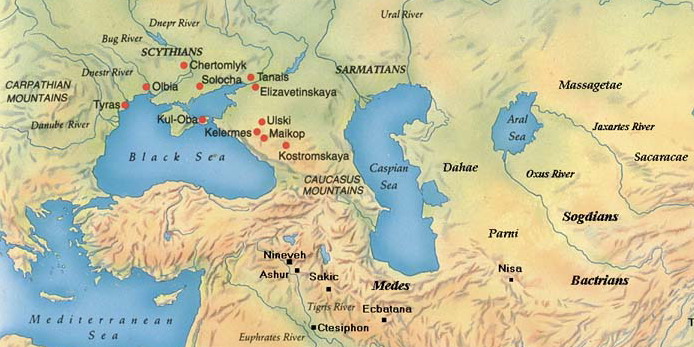Cam Rea: "The War Machine of Scythia"
The War Machine of Scythia
Israelites After the Assyrian Exile

by Cam Rea
Strive not with a man without cause, if he hath done thee no harm" (Proverbs 3;30).
And the channels of the sea appeared, the foundations of the world were discovered, at the rebuking of the LORD, at the blast of the breath of his nostrils.
He sent from above, he took me; he drew me out of many waters: (2-Samuel 22;16-17).
Put away from thee a froward mouth, and perverse lips put far from thee" (Proverbs 4;24)
The War Machine of Scythia
by Cam Rea
Introduction:
Scythia, a land inhabited by Scythians. But even this term is
very much generic. It's like saying all American's are Buckeyes even though not
all Americans are from Ohio. Scythia was a vast tract of land inhabited by many
different nomadic peoples whom for the most part were kin. The historian George
Rawlinson makes this statement about Scythia
"The term 'Scythic' is not... ethnical. It designates a life rather than a
descent, habits rather than blood. It is applied by Greeks and Romans to
Indo-European and Turanian races indifferently, provided they are nomads,
dwelling in tents... living on the produce of their flocks and herds...".[i]
The one thing the Scythians held in common was their ability to unite
and fight in times of difficulty. Now what made them most unique was their use
of the horse in combat, and the weapons they used on the field of battle.
But were did they come from and what was their motivation to
innovate? To find these answers we have to look to ancient Assyria. From here
the Assyrian sources indicate that the Scythian/Cimmerian was not native to the
land that would be called Scythia, and that their origins point to a more middle
eastern neighbor that was once independent of Assyrian rule. Only to be coveted,
and conquered, and removed, to places unknown to them for the most part. If you
would like to no more about the origins of the Scythians/Cimmerians see my
article "Sometimes They Come Back also known as the Assyrian Exile". You will
find that article on Brit-Am website. Also I have an upcoming book as well that
goes into further detail of their origins.
Earliest details:
Now this Scythian/Cimmerian military is not one that is well
documented. The earliest sources on them were from Assyria, and Assyria gives us
a glimpse into an almost absolute abyss as to how they conducted warfare or at
lest paint us a picture that is really vague. Before we go on I want to clarify
as to not confuse the reader about the use of Scythian/Cimmerian. Some may say
these are to different groups. Which is partially true and also false. The
Scythian/Cimmerian are kin, and for the most part one and the same. The
Assyrians in their inscriptions do not differentiate between the two, but at
times refer to both names in the regions they could be found.[ii]
The first inscriptions that mentions the Scythian/Cimmerian are
found during the reign of Sargon II King of Assyria. These inscriptions
primarily talk about the Kingdom of Urartu invading the land of Gamera which was
an Assyrian province at the time. The Urartu Army that invaded was defeated
by the forces of the Gimira. Gimira, in case you did not know, means Cimmerian in our
language.[iii] How the Urartu forces were defeated is not known. But what is
known is that Assyrians had horses raised in the area of Gamera [i.e. of the Gimiri] for their own
military use, under the watchful eye of the Musarkisus who were assigned to
supply the Assyrian forces with fresh horses. This also indicates that the
Gamira/Cimmerians used horses as well to supply their forces to protect
Assyria's borders from foreign invasions since the Gamira/Cimmerians were a part
of the Assyrian auxiliaries corps.[iv] Which tells us that the Cimmerians most
likely fought from horse back and not from the Chariot due to the mountainous
terrain. The inscription provided for us by the Assyrians indicates sending the
Cimmerians into Urartu due to the nature of battle which was about
to be conducted. This also shows that the Assyrians were not fully capable in
conducting mountain warfare which points to their heavy use in depending on
conquered foreigners who were well trained in arts of cavalry and not
charioteering. Also in the inscription the Gamira are mentioned by name. This
seems to indicate that the Gimira were aloud to retain their native dress in the
Assyrian military. Groups that would be aloud to retain their native dress were
referred to as "Sab Sharri" by the Assyrians. Also there is an
inscription found at Nineveh that bares the name and title: "Ubru-Harran,
chief of a Cimmerian detachment" which shows without a doubt that the
Cimmerian/Scythians were apart of the Assyrian war machine in the beginning.[v]
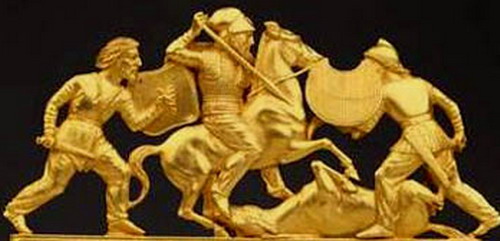
|
Scythian Warriors as Depicted by their Own Craftsmen
Horse and Rider:
What we have examined so far is that the Cimmerian/Scythian
fought from horseback and were allowed to retain their native dress. But what
about their weapons of choice? For starters their primary weapon was not the bow
but the horse. The bow was just the initial weapon and the rider was like a
turret on a tank. The horse was just the vehicle that could deliver the payload
upon the impending target chosen. But this was of great importance. For in the 7th century BCE cavalry was not as prestigious or so well taken to as were charioteers.
This would have to change if Assyria was to survive.
Assyria would over time begin to adopt the ideal of cavalry as a proven weapon,
but still relied very much on the chariot. By the time of Ashurbanipal, the
last great king of Assyria, the primary role of the cavalry was to assist or support the
chariots in battle. Once the enemy line was broken they would have a role in
mopping up the confused forces. Assyria did not use cavalry so
much when compared to its neighbors. Assyria never invested
a huge amount in developing better cavalry units whereas their enemies
(such as the Cimmerians/Scythians) would continue to evolve into much
better fighting forces adapted to natural condition and the conduct of their enemies meaning
mainly Assyria. But also we should not forget that Assyria relied on cavalry
units not native to Assyria. It is also said that Assyria began to adopt the
cavalry style of the Iranians to better compete in combat against them. This is
true for the most part, but over all it seems that the Scythians/Cimmerians did
the most in changing and adapting to their enemies weakness. [vi]
Scythian cavalry men wore a vast array of armor, and when one looks
at Scythian art work you can notice the difference with armor over a period of
time. But it seems for the most part that the Scythian cavalry man wore scale
armor. Small pieces of armor mostly iron but sometimes mixed in with bronze,
would overlap but not hide each piece of metal. This scale armor would be sewn
into the leather shirt with animal tendons. The scale armor would cover from
neck to hips. But over time the Scythians would make wide use of this scale
technology and cover their legs and arms but not to the point to constrict
movement. Their helmets would become scaled to over time, and new pieces would
be added to the helmets as well like cheek coverings and neck protection leaving
the nose exposed. As the centuries marched Scythian noblemen have been known to
wear Greek style helmets which have been found in numerous graves in the
Northern Caucasus region. But one thing I did come across which may be of
interest is that archeologist's found graves in Valsgarde Sweden that bare the
same style of Scythian armor, which dates to 450 A.D. and could have been
brought by the Cimmerians.[vii] Also I wonder if the Greeks ever considered the
Scythians as Sarmatians in the term of armor. The Greeks called the Sarmatians
"Lizard People" which could have been applied to the Scythians as
well for the dragon scale armor look they fashioned just like Sarmatians.[viii]
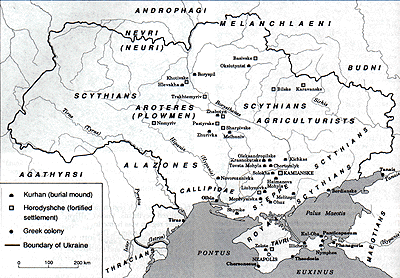
Archery and Arrows:
Now besides the Horse being the main function of the
Scythian/Cimmerian war machine, we need to examine the instrumental weapons used
in combating the enemy. For starters the bow was the primary weapon of the
rider. The bow the Scythians and Cimmerians used is a close match to the
composite bow used by many steppe worriers. The problem with the Scythian/Cimmerian
bow is that no fully intact example has yet been discovered. Every bow found has been eaten away
with time and thus a mystery still remains. But their art work does give us an
example of how it looked. What we do know from past histories is that it's
small, and could deliver an arrow 521.6 metres or 1711.282 feet which is a
little more then 567 yards according to the inscription found in a Greek grave
which says "Anaxagoras son of Dimagoras" shot such a bow in the
city of Olbia on the Dniepr-Bug estuary. This area where the inscription was
found was an area inhabited by Scythians/Cimmerians for the most part, but there
were Greek coastal cities in the area that most likely were in day to day contact
and trade with them. By being in such contact one would gain such knowledge and
use of the Scythian bow. When in war the Scythian is said to carry anywhere from
30 to 150 arrows into battle, and use them up in a range of 3 to 15 minutes
depending I would suggest on the nature of the battle.[ix] Now the arrow heads that
were developed and designed by the Scythian, and Cimmerians, were far more
superior than arrows used by their Middle East neighbors. This may indicate
that the rest of their archery equipment may have had the same superiority over
their Middle Eastern counterparts and seems to even rival those of Europe as
well. The arrows used by the Scythians have been also found in Babylonia.
This suggests that the Babylonians themselves adopted the style and use of
Scythian archery equipment in the 6th century BCE. From the
Babylonian finds one could speculate as to whether or not the Babylonians
employed Scythians amongst their ranks or at least brought in a type of military
advisor to train Babylonian archery units, whether they be cavalry or on foot in
the Scythian style of archery and mechanics. Because of this we have to ask why
were their weapons so superior? For starters we know very little of the type of
bow they used but have ideas to compare it to. Second the arrow head used by the
Scythians is far more greater and better then the traditional leaf shaped arrow
heads used in Mesopotamia. The Scythian arrow head is known as the
"Scythian point". This arrow head had more of a bullet shape with three sides and each of those three sides had very small
wings. The reason for this innovation was to penetrate armor better. Many of
these arrow heads have been found in Scythian graves dating from the 7th to 4th centuries BCE. This was a Scythian design totally of its own.
Now one thing I want to point out is the date. Notice that it says from the 7th to 4th centuries. It's the 7th I'm focusing on. The 7th century means 699 to 600 BCE. In that time period the wars between the Assyrians
and Scythians were sporadic. Now if no arrow head of this design has been found
later then the century given it suggest one thing. That for the Scythians to be
competitive in the art of war against the Assyrians, they had to find a better
way to pierce their iron armor. This arrow head design would penetrate iron.
This most likely made the Assyrians think twice when having to fight a force that could
halt, put a dent into, and even defeat them. Even though the track record shows
Assyria with the most victories it came with a heavy loss of Assyrian life,
and in turn made the Assyrians to think twice about their superiority
in Mesopotamia in the 7th century BCE. This may have been the reason
for the Babylonians to adopt armor piercing arrow heads in the 6th century BCE
among other possible Scythian style weapons. [x]
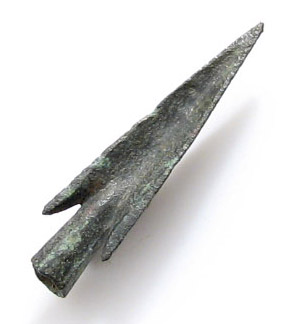
|
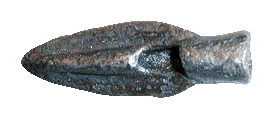
|
Scythian Arrowheads
Sword and Lance, Spear and Axe
The Scythian/Cimmerian sword was a two edged sword being
anywhere on average 60-70cm long. They were highly decorated with small gold
plates, and much art work seems to have been done as well to the sword handle,
as well as to the blade itself. Each Scythian sword for the most part is the same
as the next with the only difference being the art work that was involved in the
process of making such a weapon. It is also suggested that the Scythians borrowed
this type of sword from the Middle East and Asia Minor during their
conquests. Even though the sword appears not to be long it was great for
thrusting and slashing. Now the Scythian lance was three meters long. This type
of weapon was for mounted warfare due to the nature and length of the weapon,
and would have caused great damage to enemy infantry units that were in the way
of a frontal assault. I would suggest that most likely the heavy Scythian
cavalry men carried such a weapon, but it's also possible with the little
information we have that maybe all Scythian cavalry carried the lance. The
Scythians did carry spears but they were much shorter, and seem to be used as a
type of dart to throw at the enemy whether it was from the horse or on foot. A
cavalry man would have to get much closer to launch such a weapon at the intended
target and it seems to have been a weapon for close combat. Also the Axe was another
weapon of choice among Scythian cavalry men. It could be suggested that once all
items that could be used as projectiles were spent, sword and axe came into favor for
close combat.[xi]
Scythian Warfare:
Here comes the tricky part. Scythian warfare is not that well
documented. Almost nothing is said of their style or technique in combat when
two armies face each other. But from the information given as to the use of
the bow, lance, sword, spears, and a horse to deliver the payload, we might be
able to piece together what could have happened. My example would be Sargon II
fighting the Scythian/Cimmerians in 705 BCE. It is said that Sargon II lost his
life in battle to the Scythian/Cimmerians but the Assyrians gained the victory.
So how did the Scythians/Cimmerians penetrate the mighty Assyrian army? When
both armies meet at the desired place there may have been some negotiating
first, and some promises second. Either way the talks failed and the battle was
on. I would suggest that the Scythians/Cimmerians made the first move by sending
horse archers out in front. Now before we go on into further detail I would like
to suggest the game Rome Total War. You can find it at this website
http://www.totalwar.com/?lang=us
or you can buy it at Amazon.com, Ebay, Half.com. The reason I bring up this game
is that the people who make this game base it completely on what history has
provided us in terms of warfare and the technology that follows. This game
engine has been used a lot on the History channel programs, to give a much
better view as to how armies may have fought. Now let us get back to the battle
between Sargon II's Assyrians and the Scythian/Cimmerian forces.
The Scythian/Cimmerian horse archers may have stood together
that is to say horse next to horse and shot volleys of arrows into the Assyrian
ranks. The second proposal is that many of the horse archers broke off into two
groups and formed circles. Each circle would follow the leader in a circle
fashion at full speed firing arrows into the enemy ranks. The reason for this is
that if enemy archers are firing arrows back at you, you become a much harder
target to hit due to constant movement. Now after the horse archers expended
their supply of arrows, the next group may have rode close enough to throw
spears and darts at the enemy ranks. This is not to say that the Assyrians
didn't challenge them head on with their own cavalry. The last order of business
was probably the heavy cavalry charge to break the ranks of the infantry and to
scatter the archers. Once lines have been broken the second and third waves came
in to mop up those Assyrians left behind and to help their comrades who broke
the first few ranks continue the push forward. We need a reminder however that all this is pure
speculation. We don't know enough about the battle to make a real case. But there
is something that comes to mind. Sargon II was killed. Now it would take a
strong force, very disciplined, with a strong distaste for anything Assyrian to
break their ranks. What I'm going to propose is this. It seems that in order to
reach and kill the king, the Scythians/Cimmerians had gone for broke. That is to
say that after all they fired, propelled, projected, the Assyrian forces would
not budge and showed no sign of significant weakness, which lead to an all out
surprise attack that probably shocked the Assyrian ranks and brought fear to
them to bend and not break. Most likely the heavy cavalry broke through the
Assyrian ranks far enough as to let the much light units carrying spears and
javelins reach Sargon II and thrusting them deep into his body causing him to
fall before his most trusted generals and most important his men.[xii] It was a
victory for both sides.
Conclusion:
This is what have learned about the Scythian/Cimmerian war machine.
One, they were fast and could maneuver with speed. Second their weapons were
light and practical: Lances, short swords, axes, javelins, spears, and bows were
great for a cavalry man. Third, their armor didn't slow them down. Instead it
was innovating and brilliant for their time. Not only that, it was also great
against arrows and could ward off sword blows. Fourth, the Scythian/Cimmerians war
machine by far was very complex yet practical. Speed and stealth was the object
of their game. They would feint a retreat causing their enemies to pursue them, and then be engulfed by a vast number of arrows that the Scythians would pour down on
them. Fifth, they were a society separated by clans and tribes. In times of
war they got together and became a single fighting unit. This goes to show that
nations like Assyria and Persia could not stand up to the raw power of blood-relationship
over steel.
[i] Rawlinson, The Sixth Oriental Monarchy, p. 20
[ii] Yair Davidiy, Origin, p. 40-43
[iii] Capt, Missing Links Discovered in Assyrian Tablets, p. 111
[iv] Gabriel, The Great Armies of Antiquity, p. 133
[v] Capt, Missing Links Discovered in Assyrian Tablets, p. 111/
Yair Davidy,
Lost Israelite Identity, p. 71
[vi] Healy, McBride, The Ancient Assyrians, p. 9, 20, 21
[vii] Cernenko, McBride, Gorelik, The Scythians 700-300 BC, p. 7/ Oakeshott,
The Archeology of Weapons, p. 67
[viii] Brzezinski, Mielczarek, The Sarmatians 600 BC-AD 450, P. 6
[ix] Cernenko, McBride, Gorelik, The Scythians 700-300 BC, p. 11-14
[x] Virtual Karak Resources Project and
Appalachian College Association/ http://www.vkrp.org/studies/historical/scythian-point/
2001-2007/ Gershevitch, The Cambridge History of Iran, p. 92
[xi] Cernenko, McBride, Gorelik, The Scythians 700-300 BC, p. 14-20
[xii] Gabriel, The Great Captins of Antiquity, p. 52/Chahin, The Kingdom of
Armenia, 90, 94/
http://www.totalwar.com/?lang=us
Also by Cam Rea
From Parthia to Gothica
"Sometimes They Come Back". The Assyrian Exile
See also,
Articles on this subject by Yair Davidiy:
The Completeness of the Exile
What Spake Zarathustra?
The Cimmerians, Scythians, and Israel
Scythians
Pictures of Ancient Hebrews: Hebrew Types
THE ISRAELITE
ORIGIN OF THE SCYTHIANS
by Steven Collins
Correspond with us
Send Comments or Criticisms
You may not always receive an immediate answer but anything you say will be considered and appreciated
Send us an
e-mail
Books and Offering Opportunities
Main Page


